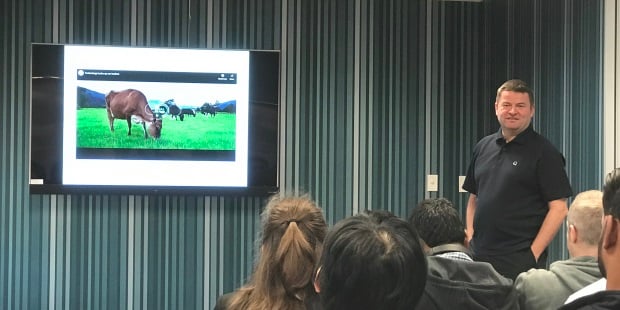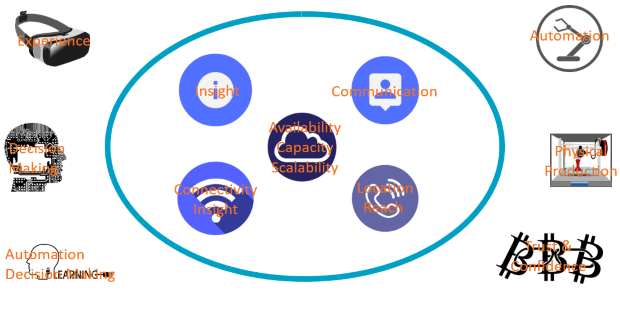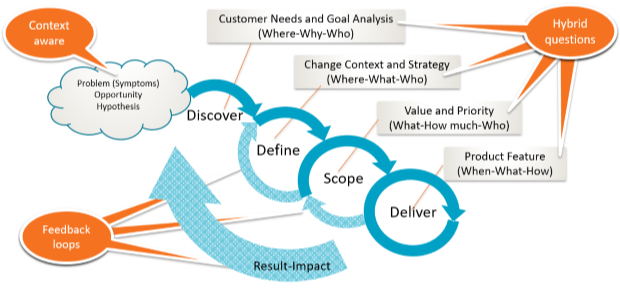Share this
Presenting on digital business analysis at IIBA meet-up
by John Barris on 26 June 2019

Last week I presented on the topic 'Digital business analysis - thinking differently in the age of digital disruption' at the International Institute of Business Analysis (IIBA) meet-up in Wellington.
Here is a summary of some of the points that I made:
- Disruption is not just a 21st century problem - think about the disruption to the transport industry as we moved from horse-drawn carriages to cars. We moved from blacksmiths to mechanics and stables to petrol stations.
- The MIT Sloan Center for Information Systems Research (CISR) introduced the acronym SMACIT to highlight the technologies that are driving disruption today - Social Media, Mobile, Analytics, Cloud and Internet of Things. IDC extended this set with their '3rd Platform' to include amongst others Augmented Reality, Artificial Intelligence, Machine Learning, Robotics, 3D Printing and Blockchain.
- As business analysts we need to look beyond these technologies to the opportunities they present.
| Technology | Opportunity |
| Social Media | Communication |
| Mobile | Location, reach |
| Analytics | Insight |
| Cloud | Availability, capacity, scalability |
| Internet of Things | Connectivity, insight |
| Augmented Reality | Experience |
| Artificial Intelligence | Decision making |
| Machine Learning | Automation, decision making |
| Robotics | Automation |
| 3D Printing | Physical production |
| Blockchain | Trust, confidence |
Look beyond the technology to the opportunity

- As we then bring these technologies and opportunities together in combination we get further opportunities, such as driver-less cars.
- Digital disruption is changing customer expectations and this increasingly means we need to disrupt ourselves, invest in digital capabilities, reinvent our organisations with the customer in mind, and collaborate with others in our ecosystems.
- As business analysts we need to look beyond our business to our customers and our ecosystems. This may involve substantial change in how we approach customer experience, operational excellence and the creation of new products.
- This in turn means that as business analysts we need to look beyond our standard business analysis tasks to the outcomes we need to deliver.
- As we move from 'users' to 'customers' the 'Who' question becomes central to business analysis, where previously we focused on 'Why', 'What' and 'How'.
- This leads to hybrid questions 'who's why where?', 'where what and who needs to change?', 'who cares how much about what?' and 'when should what happen and how?'
- Requirements move more to hypotheses, that you can test and if they are proven to be right, they were the requirement. Our treatment of scope moves from 'boundaries' to 'focus' and that focus may change as decisions are made on which items on an Agile backlog have the highest priority now.
- I presented the following diagram as an updated business analysis approach model for a Digital, Agile or Lean context:
Digital / Agile / Lean analysis approach model

- For 'Discover' I stressed the importance of going beyond the business to the customer, using frameworks such as Dave Snowden's Cynefin Model, being visual with canvases and maps (not full requirements documents), and using approaches such as design thinking to diverge and converge.
- For 'Design' I spoke about thinking of customers, environments and ecosystems rather than users, systems and businesses. I emphasised the importance of a 'lite' approach but still one that is 'considered'.
- For 'Scope' I encouraged the audience to move away from seeing it as a boundary and towards seeing it as a focus on value driven increments. I also suggested to move away from being product oriented and focus on outcomes and capabilities.
- For 'Deliver' I discussed the idea of story mapping to deliver fast but meaningful results, but expanding backlog items to include other business change work items such as insight stories, business stories, integration, configuration and process stories.
- A fundamental part of the approach is feedback loops for collaboration, learning, adapting, gaining feedback and continuously improving.
Thank you to the IIBA for running the event and to Momentum for providing the venue for the presentation.
John Barris is a Principal Consultant specialising in business transformation and business analysis, based in our Wellington office.
Topics:
Business Analysis
Innovation
Requirements
Capability Development
Digital Disruption
Digital Transformation
Change Management
Share this
- Agile Development (153)
- Software Development (126)
- Agile (76)
- Scrum (66)
- Application Lifecycle Management (50)
- Capability Development (47)
- Business Analysis (46)
- DevOps (43)
- IT Professional (42)
- Equinox IT News (41)
- Agile Transformation (38)
- IT Consulting (38)
- Knowledge Sharing (36)
- Lean Software Development (35)
- Requirements (35)
- Strategic Planning (35)
- Solution Architecture (34)
- Digital Disruption (32)
- IT Project (31)
- International Leaders (31)
- Digital Transformation (26)
- Project Management (26)
- Cloud (25)
- Azure DevOps (23)
- Coaching (23)
- IT Governance (23)
- System Performance (23)
- Change Management (20)
- Innovation (20)
- MIT Sloan CISR (15)
- Client Briefing Events (13)
- Architecture (12)
- Working from Home (12)
- IT Services (10)
- Data Visualisation (9)
- Kanban (9)
- People (9)
- Business Architecture (8)
- Communities of Practice (8)
- Continuous Integration (7)
- Business Case (4)
- Enterprise Analysis (4)
- Angular UIs (3)
- Business Rules (3)
- Java Development (3)
- Lean Startup (3)
- Satir Change Model (3)
- API (2)
- Automation (2)
- GitHub (2)
- Scaling (2)
- Toggles (2)
- .Net Core (1)
- Diversity (1)
- Security (1)
- Testing (1)
- February 2024 (3)
- January 2024 (1)
- September 2023 (2)
- July 2023 (3)
- August 2022 (4)
- August 2021 (1)
- July 2021 (1)
- June 2021 (1)
- May 2021 (1)
- March 2021 (1)
- February 2021 (2)
- November 2020 (2)
- September 2020 (1)
- July 2020 (1)
- June 2020 (3)
- May 2020 (3)
- April 2020 (2)
- March 2020 (8)
- February 2020 (1)
- November 2019 (1)
- August 2019 (1)
- July 2019 (2)
- June 2019 (2)
- April 2019 (3)
- March 2019 (2)
- February 2019 (1)
- December 2018 (3)
- November 2018 (3)
- October 2018 (3)
- September 2018 (1)
- August 2018 (4)
- July 2018 (5)
- June 2018 (1)
- May 2018 (1)
- April 2018 (5)
- March 2018 (3)
- February 2018 (2)
- January 2018 (2)
- December 2017 (2)
- November 2017 (3)
- October 2017 (4)
- September 2017 (5)
- August 2017 (3)
- July 2017 (3)
- June 2017 (1)
- May 2017 (1)
- March 2017 (1)
- February 2017 (3)
- January 2017 (1)
- November 2016 (1)
- October 2016 (6)
- September 2016 (1)
- August 2016 (5)
- July 2016 (3)
- June 2016 (4)
- May 2016 (7)
- April 2016 (13)
- March 2016 (8)
- February 2016 (8)
- January 2016 (7)
- December 2015 (9)
- November 2015 (12)
- October 2015 (4)
- September 2015 (2)
- August 2015 (3)
- July 2015 (8)
- June 2015 (7)
- April 2015 (2)
- March 2015 (3)
- February 2015 (2)
- December 2014 (4)
- September 2014 (2)
- July 2014 (1)
- June 2014 (2)
- May 2014 (9)
- April 2014 (1)
- March 2014 (2)
- February 2014 (2)
- December 2013 (1)
- November 2013 (2)
- October 2013 (3)
- September 2013 (2)
- August 2013 (6)
- July 2013 (2)
- June 2013 (1)
- May 2013 (4)
- April 2013 (5)
- March 2013 (2)
- February 2013 (2)
- January 2013 (2)
- December 2012 (1)
- November 2012 (1)
- October 2012 (2)
- September 2012 (3)
- August 2012 (3)
- July 2012 (3)
- June 2012 (1)
- May 2012 (1)
- April 2012 (1)
- February 2012 (1)
- December 2011 (4)
- November 2011 (2)
- October 2011 (2)
- September 2011 (4)
- August 2011 (2)
- July 2011 (3)
- June 2011 (4)
- May 2011 (2)
- April 2011 (2)
- March 2011 (3)
- February 2011 (1)
- January 2011 (4)
- December 2010 (2)
- November 2010 (3)
- October 2010 (1)
- September 2010 (1)
- May 2010 (1)
- February 2010 (1)
- July 2009 (1)
- April 2009 (1)
- October 2008 (1)